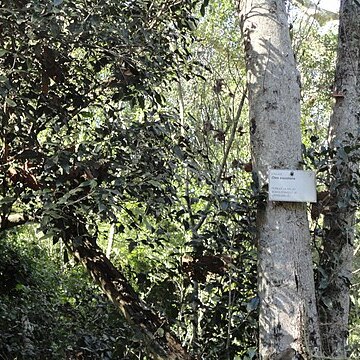Tree, 4-17 m, rarely 30 m high, with whitish bark, smooth or fluted; ultimate twigs pale grey or whitish, more or less lenticellate, at least some of the upper internodes 4-angled. Leaves lanceolate-elliptic to elliptic, usually broadest about the middle and from there narrowing to an acute base and apex (apex sometimes rounded), 4-8 cm long, 0.8-3.3 cm broad, flat with just the marginal rim reflexed and often loosely undulate, minutely scaly, giving the appearance of being minutely pitted, especially on lower surface, midrib more or less impressed above, prominent below, lateral veins sometimes faintly obvious, then prominent above, anastomosing in large loops near the margins (loops not forming an almost straight line along the margin); petiole 4-10 mm long. Panicles axillary and quite frequently terminal too, many flowered but not dense and compact; branches slender, subterete, 4-angled or variously flattened and fluted, internodes and peduncles relatively long, pedicels short; bracts up to 4 mm long, sub-deciduous. Calyx small, cupular and shortly 4-lobed, up to 1 mm long. Corolla white; tube 0.75 mm long; lobes about 2.25 mm long and 1.5 mm broad, forming a subglobose bud, eventually reflexed. Stamens with filaments inserted on the tube, free for about lmm, anthers 1.5 mm long, 1-25 mm broad, more or less medifixed. Ovary subglobose; style very short; stigma 2-lobed conico-globose; ovules pendulous. Drupe drying blackish, semi-ovoid, narrowing to apex and oblique at base, usually about 1 cm long and 5 mm broad in dried specimens, occasionally slightly larger.
More
Medium to large tree, 2-20 m high. Leaves opposite, papyraceous, uniformly coloured, apex and base acute, margins entire. Inflorescences trichotomous panicles, many-flowered, not dense or compact; peduncles relatively long. Flowers small, white; pedicels short. Sepals 4-lobed, fused basally. Corolla 4-lobed, partially fused into small tube. Stamens 2, inserted on corolla. Ovary subglobose; stigma bilobed. Flowering time Oct.-May. Fruit a drupe, semi-ovoid, narrowing to apex, oblique at base; pericarp thinly fleshy, black when mature.
Tree, 4-17 m, rarely 30 m high. Leaves fairly sparsely and very minutely scaly below appearing minutely pitted, lanceolate-elliptic to elliptic, usually broadest about the middle and from there tapering to base and apex. Inflorescence axillary as well as terminal. Flowers white.


